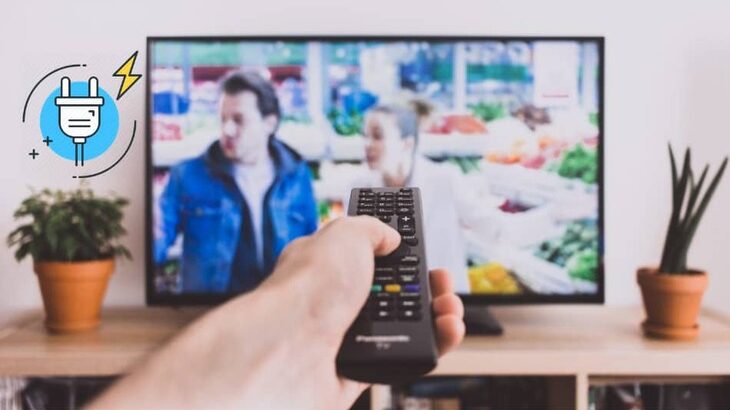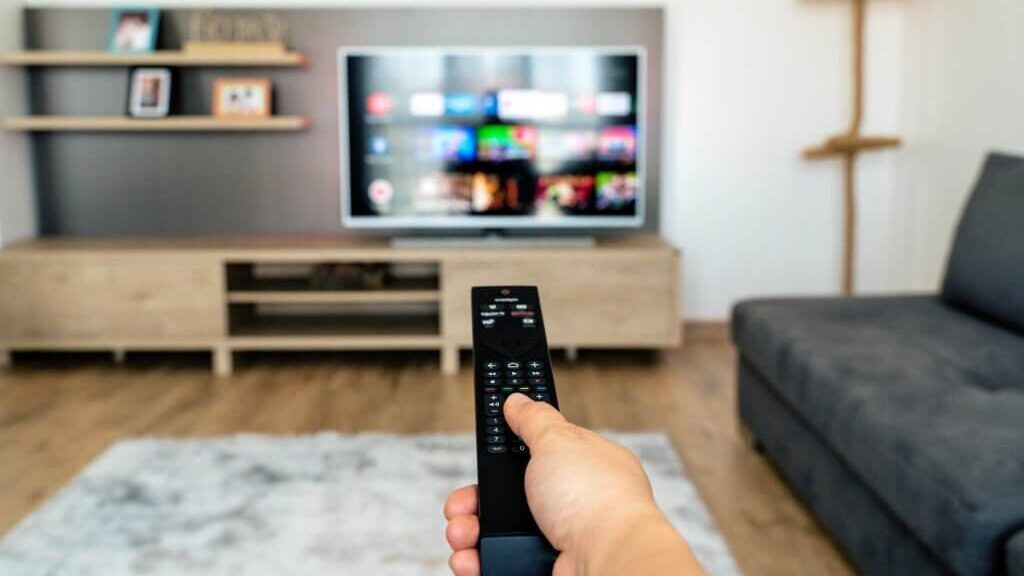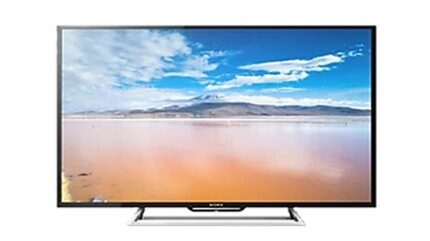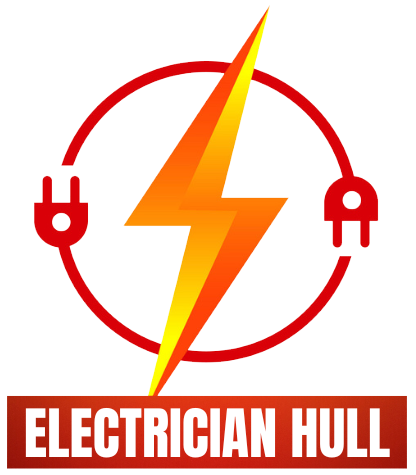With the number of household appliances growing, so is energy consumption.
TVs are no exception to this trend and can significantly impact your monthly bill if you do not know how much electricity does a tv use in the UK.
There are many different types of models that range in size depending upon their function.
Some may be ultra-high-definition, while others still only offer standard HD quality.
All contain varying degrees of features like 3D support, which typically requires more processing power.
How Much Electricity Does A Tv Use?
Your average TV uses 80 to 400 watts when it is turned on, but that also depends on the size and technology.
Using a sample cost of 13¢ per kilowatt-hour and watching time five hours every day, we get around $0.13 in return for our money invested each month. This would be enough for 1 – 7 dollars depending on if you buy monthly or annually.

The amount of energy used by TVs to power itself is small compared with other devices in your home.
Heating and cooling systems use an average of 14% more than fluorescent lights, while electricians say that heating consumes up 20-30%.
Yet even though they only make up 10% as much consumption overall. Most people are still misinformed about how their favourite gadgets affect them financially.
How Much Electricity Does A TV Use Per Hour?
TV uses more than 236 wattages per hour, but if you like watching it on the TV rather than on your computer screen, this number should be much lower.

The average American spends 4 hours 15 minutes each day in front of their set. That is only about 10% less time spent looking at screens than how long people spend driving or doing other daily tasks.
Electricity Usage By TV Type / Types Of TVs
The following are types of TVs and their electricity usage;
1. LCDs
LCD panels started slowly making their way into homes in the late 1990s and early 2000s.
Compared with others, the big thing about these sets is that they are slimmer, which allows you to put them on a wall for better placement or aesthetic purposes.
30 inch: 30-inch LCDs are a great choice if you are looking into saving money on your electricity bill because they only consume around 60 watts while playing back videos which means less power being used overall.
Forty-three inches: With a 42 inch LCD tv, you are using 120 watts. To put this in perspective for your home electricity usage. If every person watched 4 hours of TV per day on average, then it would take less than two years before all their power was used up.
Fifty inches: The 50″ LCD TV is energy efficient. It uses only 150 watts, which means that it will give off less heat than an old television with larger screens and take up less space on your wall.
2. Plasma
Plasma is a gas capable of conducting electricity on an atomic level. With more energy supplied, there are collisions between particles and release light in the form of photons when they collide with each other or something else, such as air molecules.
The power requirements for every component in your living room will vary depending on the size of the screen and how many watts it consumes.
A 42-inch model often sucks up 200 to 500 kilowatts, and a 60. plus inch plasma can use between 500kW –600 kW
3. LEDs
The average LED TV uses just 107.7 kWh per year, or about the same as a 75W lightbulb! The highest recorded consumption was 117 watts and the lowest 10.
It is interesting to note that these TVs use less power when they’re turned off than in standby mode (0.5 W).
4. Smart TV
A 100 watt TV running for 12 hours every day will consume 1200 watts-hour (1.2 kWh) of electricity in a day. And 36-kilowatt hours over an entire month, which is about the average consumption levels among LED smart TVs today.

You are fully adjusted for changes due to factors such as climate control usage or watching Netflix live streams on your computer instead can result in saving up to 15% off this number.
What Determine Your TV’s Energy Consumption?
The following are some of the things that determine your TVs energy consumption;
Type Of TV You Have
The type of TV you have can determine the amount and style that it uses.
For example, a 50″ LCD or LED-based television will use less energy than an older CRT set.
Because they produce very little heat as well as consume electricity at much lower rates for their size due to being flat instead of round like tube TVs were made out them during this era in history.
However, there’s more than just how big your screen is when considering this issue; quality does matter too.
Size
The size of your TV also determines the amount of energy it uses.
A study by Energy Star found that TVs with screens between 40 and 75 inches use about 60% more power than those up to 50 inches wide.
The most efficient TVs on the market use much less power. Some LED models use 15 watts for a 15-inch TV, which is about 1/3 of what you would need with an old CRT set and more than 2x as efficient.
Location in The House
If you have a large house, it may be that your TV is placed in an area with poor insulation. The cold winter months cause more energy to flow through these walls and into heating bills to keep homes warm enough for our family members!
The proper placement can make all the difference when considering how much power your television uses each day.

Especially during those long dark days before December 25th rolls around again this year.
You do not want any bright lights distracting from what matters at home: spending time together as families who love one another very much despite circumstances out of their control.
Length Of Time
You would probably be surprised to know that the length of time you watch your TV can affect your energy consumption.
For example, 30 minutes in front of CNN cause 10% more electricity used than when it’s off altogether.
That is because when people are watching their favourite news channel, they tend to focus attention there, so they pay better attention and use up resources needed for them not only to see but hear what’s going on around them too.
What Affects Energy Consumption?
The following are some of the factors that affect energy consumption;
- The size and weight of the TV
The size and weight of a TV have been found to affect how much energy it takes.
TVs with smaller screens use less power than those that are more extensive, especially if they’re placed against another good-sized wall for receiving signals from every source possible.
This can be partly because there isn’t enough room inside the cabinet where all these wires come out.
Suppose you want your house guests (or even yourself) not only to enjoy great reception but save money at night while doing so. Make sure that any new screen is no bigger than 40 inches diagonally.
- Type of TV
The type of TV you have can be a factor in how much energy it uses.
For example, LCD screens require less power than CRTs because they use low voltage and emit light instead of electricity through heating elements or electron guns.
Fibre-optic systems also offer an eco-friendly choice.
These do not need any actual wires to transmit information from one place, all while using significantly fewer resources than other technologies out there today.
- How much time the TV is on
The more time the TV is used, the greater its energy consumption.
The powering of television sets could have an effect on your electricity bill and cost for heat in winter months if left turned on all day long without being appropriately utilized by people who live alone.
Or do not use it often enough to make up for lost charge times due to not having any appliances running at home like washer/dryers etc.
- Brightness and contrast settings
TV sets are designed to provide a great viewing experience, but they also use energy.
The brightness and contrast settings on your TV can affect how much you spend for one, so make sure that these things work best for both quality and affordability.
How to Check Your TV’s Power Consumption?
This is how you can check your Tv’s power consumption;

- Check your TV’s power consumption by turning it on and off.
- Turn on the TV and measure how much electricity it consumes over a period of time
- Find out how many watts a TV consumes by multiplying the voltage and current together
- Multiply that number with 1,000 to get the watt-hours consumed per day
- Buy a wattmeter to see the exact power consumption
What is Energy Efficiency Class?
The energy efficiency of your appliance is rated from A-G, with the most efficient being labelled as such.
Other helpful information includes how many cubic feet it can hold, what is inside, and if there are any hidden costs associated with buying one model over another.
All things considered before making a decision on which model will best suit your needs.
There are five classes of power consumption for plasma and liquid crystal TVs, with the most efficient being ‘A’ rated.
The following four classes have their rating symbols ranging from + up to -. These designations were introduced in 2010 but weren’t finalized until 2020 when they added an extra letter at last.
You can still see some old models using B through G labels if yours was made before this date, though, because these ratings did not come into effect globally until then.
Either way, all new sets will be labelled accordingly by law across countries where it applies starting 2021.
3 TV Models With Low Electricity Consumption
The following are the models with low electricity consumption;
LG 55LH6407
The LG 55LH6407 is a model that saves you money on your electric bill.
This television has an energy-efficient design with low consumption rates of just over 50 watts per hour. Making it perfect for anyone who wants peace of mind knowing they are not wasting power when watching their favourite show at home.
Philips 49PUS6101
The new Philips 49PUS6101 4K TV is the perfect choice for those looking to save power and money on their electricity bill. At just 66 W per hour, this television will have you laughing back from Mom-and Dad’s house.
Samsung UE49M6302
The Samsung UE49M6302 is a model with low electricity consumption. Its diagonal size of 49 inches consumes only 62 watts per hour.
And it has an average load for the year which means that 92 kW will be spent on servicing such equipment each year.

Standby Power (Vampire Power) Of TV’s
TVs used to have a much bigger standby power consumption problem than they do today.
Modern and new TVs are more energy-efficient, so it’s no surprise that the industry has found ways of solving this issue.
Standby mode on your TV was once considered an Achilles heel before making better choices for ourselves as consumers.
In 2006, many TVs were drawing so much power in standby mode that it would wake up the entire house. Nowadays, this is a thing of the past as TV manufacturers have corrected this shortcoming with overwhelming success.
How Much Electricity Does A TV Use FAQ’s
How much electricity does a tv use per hour in the UK?
The average 55-inch smart television uses about one unit of electricity to power it for 12 hours, that is less than two pence per hour!
How much electricity does a tv use in a day?
The power of a LED TV varies depending on the size and quality.
A 100-watt television running 12 hours every day will use 1 kilowatt-hour (kWh) in one month, or 36 kWh over 30 days – about as much energy as some people consume daily.
How much electricity does a tv use per month?
One 120-watt television sets the power consumption record for an LED TV.
This device, capable of displaying at least four hours per day and twelve-hour days on average, uses 1.2 kWh each month or 36-kilowatt hours every week.
How much electricity does a tv use if left on all night?
A typical 65-inch television draws about 90 watts when turned on for four hours and off again.
In other words, if your set is left powered on all night at 4 hours per day, it will use around 600kWh of energy over one month.
How much electricity does a tv use on standby?
The standby mode electricity estimates range from about 2.25% to 5%, which means that if you let your TV burn through an entire day’s worth of energy in just 15 minutes,
it will use up enough for five other people who don’t watch any television at all.
How much electricity does a plasma tv use?
The amount of power a TV consumes is usually determined by its size.
A 42-inch model often consumes up to 200 to 500 watts, and some plasmas can have as much output as around 600W.
How much electricity does a 32-inch LCD tv use?
A 32″ screen, on average, consumes 70 watts of energy per hour to operate and display images.
Do 4K TVs use more electricity?
Comparing a 4K TV and an HDTV has been shown to use on average 30% more power.
This can become concerning when you consider where your energy comes from or what else might be going wrong with the household bill at night time.
Which TV uses more electricity?
Though LCD and Plasma TVs are still prevalent, the new breed of LED TVs has made them look like they’re from another era.
The average power consumption for an LED TV is only about one-third that of a plasma model.
Does a TV use more electricity than a light bulb?
65 inch LED TVs are more energy-efficient than their LCD counterparts and use less electricity.
When you switch your incandescent bulbs for an LED version or put them out of commission entirely, 2-3 will be able to power these TV sets over one year.
Wrapping it up!
We hope you enjoyed our blog post about how much electricity does a TV use. If you have any questions or want to learn more ways to help with your energy needs, do not hesitate to get in touch with us today.



Comments are closed.